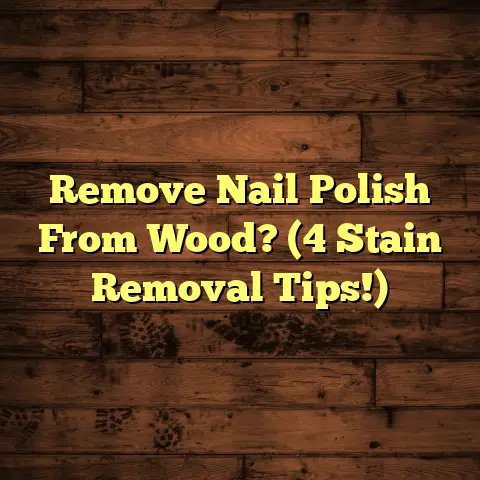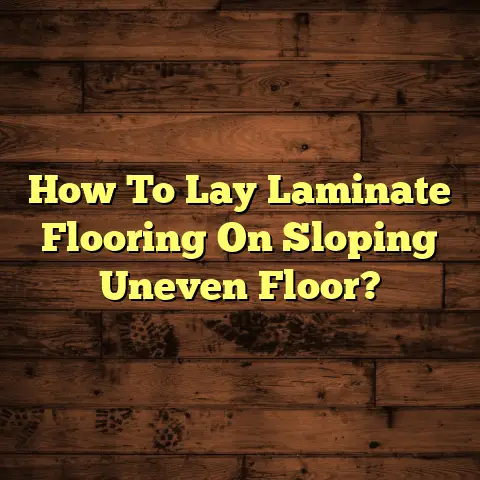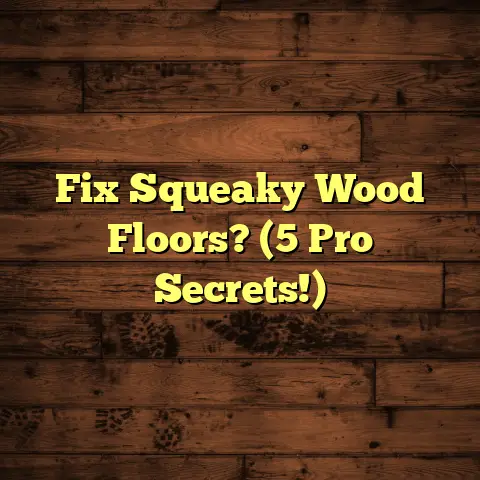Removing Varnish From Wood Floor?
Finding the Best Option for Your Home
I’m a flooring contractor, and I’ve seen it all when it comes to wood floors.
Today, we’re diving deep into the world of varnish removal – a topic that can seem daunting, but trust me, it’s totally manageable.
Let’s talk about choosing the “best option.”
What does that even mean?
Well, it’s all about finding the method that works best for your specific situation.
Think about the type of varnish, the condition of your floors, and your own comfort level with different tools and techniques.
Why would you even want to remove varnish?
Maybe you’re dreaming of restoring the natural beauty of your wood. Perhaps you’re prepping for a fresh coat of stain or a different type of finish altogether. Or maybe, like many homeowners, you’re just dealing with the inevitable wear and tear that comes with time.
Whatever your reason, the key is to find a method that’s both effective and safe – one that will give you the results you want without causing unnecessary damage to your precious wood floors. Let’s get started!
Section 1: Understanding Varnish on Wood Floors
Okay, first things first: What exactly is varnish?
Simply put, varnish is a transparent, hard, protective finish applied to wood surfaces.
It’s designed to seal the wood, enhance its appearance, and protect it from things like scratches, moisture, and UV damage.
Think of it as a shield for your floors!
Now, there are different types of varnish out there.
The two main categories you’ll encounter are oil-based and water-based varnishes.
Oil-based varnishes are known for their durability and rich, amber hue. They tend to yellow over time, which can add a warm, traditional look to your floors.
However, they also have a stronger odor and take longer to dry than their water-based counterparts.
Water-based varnishes, on the other hand, are more eco-friendly, have lower VOCs (volatile organic compounds), and dry much faster.
They also tend to be clearer and less likely to yellow over time, which is great if you want to maintain the natural color of your wood.
Here’s a quick table summarizing the key differences:
| Feature | Oil-Based Varnish | Water-Based Varnish |
|---|---|---|
| Durability | Excellent | Good |
| Color | Amber, yellows with age | Clear, less yellowing |
| Odor | Strong | Low |
| Drying Time | Long | Short |
| VOCs | High | Low |
| Clean Up | Mineral spirits | Soap and water |
Varnish provides crucial protection.
It acts as a barrier against everyday wear and tear, preventing scratches, scuffs, and stains.
It also helps to protect the wood from moisture, which can cause warping, swelling, and even rot.
And, as I mentioned earlier, some varnishes contain UV inhibitors that help to prevent the wood from fading or discoloring due to sunlight exposure.
Section 2: Signs That Varnish Needs to Be Removed
So, how do you know when it’s time to say goodbye to your old varnish? Here are a few telltale signs:
-
Dullness: Over time, varnish can lose its luster and become dull and lifeless.
This is often due to scratches, scuffs, and the buildup of dirt and grime.
-
Peeling: If the varnish is starting to peel or flake, it’s definitely time for a refresh.
Peeling varnish not only looks bad, but it also leaves the wood underneath vulnerable to damage.
-
Discoloration: As I mentioned earlier, oil-based varnishes tend to yellow over time.
While some people like this look, others may prefer to remove the old varnish and start fresh with a clear finish.
-
Cracking: Cracks in the varnish can allow moisture to seep into the wood, leading to further damage.
If you notice widespread cracking, it’s best to address the issue sooner rather than later.
Beyond these visual cues, there are certain situations where varnish removal is simply necessary.
For example, if you’re planning to refinish your wood floors with a new stain or finish, you’ll need to remove the old varnish first to ensure proper adhesion.
Or, if you’re switching from an oil-based finish to a water-based finish (or vice versa), removing the old varnish is generally recommended to avoid compatibility issues.
Here’s a real-life example: I once worked with a client who wanted to lighten the look of their dark, traditional oak floors. The existing oil-based varnish had yellowed significantly over the years, making the floors look even darker.
To achieve the client’s desired look, we had to completely remove the old varnish before applying a lighter stain and a clear, water-based finish.
Section 3: Preparing for the Varnish Removal Process
Alright, you’ve decided it’s time to remove that old varnish. Before you dive in, it’s crucial to gather your supplies and prepare your workspace.
Here’s a rundown of the tools and materials you’ll need:
- Sanders: Depending on the method you choose, you may need an orbital sander, a drum sander, or both.
- Sandpaper: Make sure you have a variety of grit levels on hand, ranging from coarse (for removing the varnish) to fine (for smoothing the wood).
- Scrapers: A good-quality scraper can be helpful for removing stubborn varnish, especially in corners and along edges.
- Chemical Stripper: If you opt for chemical stripping, choose a stripper that’s specifically designed for wood floors.
- Heat Gun: If you’re using a heat gun, make sure it has adjustable temperature settings.
- Putty Knife: For applying and removing chemical strippers.
- Safety Glasses: Protect your eyes from dust, splashes, and debris.
- Respirator: Especially important when sanding or using chemical strippers, as these processes can release harmful particles and fumes.
- Gloves: Protect your hands from chemicals and abrasive materials.
- Drop Cloths: Cover any furniture or areas you want to protect from dust and spills.
- Shop Vacuum: For cleaning up dust and debris.
- Mop and Bucket: For cleaning the floor after varnish removal.
Once you’ve gathered your supplies, it’s time to prepare your workspace. Start by removing all furniture, rugs, and other items from the room.
Next, thoroughly clean the floor to remove any dirt, dust, or debris. This will help to ensure that the sanding or stripping process is as effective as possible.
Now, let’s talk safety. Varnish removal can be a messy and potentially hazardous process, so it’s important to take precautions to protect yourself and your home.
Ventilation is key. Open windows and doors to ensure adequate airflow, especially when sanding or using chemical strippers.
Always wear safety glasses, a respirator, and gloves. These will protect your eyes, lungs, and skin from harmful particles and chemicals.
Follow the manufacturer’s instructions carefully when using chemical strippers or heat guns. These products can be dangerous if used improperly.
Be mindful of fire hazards. Some varnish removal methods, such as heat guns, can pose a fire risk if not used carefully. Keep a fire extinguisher nearby and never leave a heat gun unattended.
Section 4: Various Methods of Removing Varnish
Alright, let’s get down to the nitty-gritty: the different methods you can use to remove varnish.
I’ll walk you through each option, highlighting the pros, cons, and step-by-step instructions.
Method 1: Sanding
Sanding is a classic and effective method for removing varnish from wood floors. It involves using abrasive sandpaper to gradually wear away the varnish layer by layer.
There are two main types of sanders you can use for this purpose: orbital sanders and drum sanders.
Orbital sanders are smaller, handheld sanders that move in a circular motion. They’re relatively easy to control and are great for removing varnish from smaller areas and along edges.
Drum sanders, on the other hand, are larger, more powerful machines that are designed for sanding entire floors. They can remove varnish much faster than orbital sanders, but they also require more skill and experience to operate safely.
When sanding varnish, it’s important to start with a coarse grit sandpaper (such as 40-60 grit) to remove the bulk of the varnish. Then, gradually work your way up to finer grits (such as 80-120 grit) to smooth the wood and remove any scratches.
Here’s a step-by-step guide to sanding varnish:
- Prepare the floor: As I mentioned earlier, start by cleaning the floor thoroughly and removing any furniture or obstacles.
- Choose your sander: For smaller areas and edges, an orbital sander is a good choice. For entire floors, a drum sander will be more efficient.
- Start with a coarse grit: Begin by sanding the floor with a 40-60 grit sandpaper to remove the bulk of the varnish.
- Overlap your passes: When sanding, overlap each pass by about 50% to ensure even removal of the varnish.
- Work your way up to finer grits: Once you’ve removed the bulk of the varnish, switch to an 80-120 grit sandpaper to smooth the wood and remove any scratches.
- Vacuum and clean: After sanding, vacuum the floor thoroughly to remove all dust and debris. Then, wipe the floor with a damp cloth to remove any remaining residue.
Advantages of sanding:
- Effective at removing varnish
- Relatively inexpensive
- Allows for precise control over the amount of varnish removed
Disadvantages of sanding:
- Can be time-consuming and labor-intensive
- Creates a lot of dust
- Requires skill and experience to operate a drum sander safely
Method 2: Chemical Stripping
Chemical stripping involves applying a chemical stripper to the varnish, allowing it to soften and lift, and then scraping away the softened varnish.
There are many different types of chemical strippers available, but they all work on the same basic principle.
They contain solvents that break down the chemical bonds in the varnish, causing it to lose its adhesion to the wood.
When choosing a chemical stripper, look for one that’s specifically designed for wood floors. Avoid strippers that contain harsh chemicals like methylene chloride, as these can be harmful to your health and the environment.
Here’s a step-by-step guide to chemical stripping:
- Prepare the floor: As with sanding, start by cleaning the floor thoroughly and removing any furniture or obstacles.
- Apply the stripper: Using a brush or putty knife, apply a thick, even layer of chemical stripper to the varnish.
- Allow it to dwell: Follow the manufacturer’s instructions for how long to let the stripper dwell. This is typically 20-30 minutes.
- Scrape away the varnish: Using a putty knife or scraper, carefully scrape away the softened varnish.
- Neutralize the surface: After removing the varnish, neutralize the surface with a neutralizing agent recommended by the stripper’s manufacturer.
- Clean the floor: Finally, clean the floor thoroughly with a damp cloth to remove any remaining residue.
Advantages of chemical stripping:
- Can be less labor-intensive than sanding
- Effective at removing varnish from intricate surfaces and hard-to-reach areas
- Doesn’t create as much dust as sanding
Disadvantages of chemical stripping:
- Can be messy and time-consuming
- Requires careful handling of chemicals
- May not be as effective on certain types of varnish
Method 3: Heat Gun
A heat gun is a tool that emits a stream of hot air. When directed at varnish, the heat softens the finish, making it easier to scrape away.
This method can be particularly useful for removing varnish from small areas, intricate moldings, and hard-to-reach corners.
However, it’s important to use a heat gun carefully, as excessive heat can damage the wood or even start a fire.
Here’s a safety guide for using heat guns effectively:
- Use adjustable temperature settings: Start with a low heat setting and gradually increase the temperature as needed.
- Keep the heat gun moving: Don’t hold the heat gun in one spot for too long, as this can cause the wood to overheat.
- Use a scraper to remove the softened varnish: As the varnish softens, use a putty knife or scraper to carefully remove it.
- Work in a well-ventilated area: Heat guns can release fumes, so it’s important to work in a well-ventilated area.
- Be mindful of fire hazards: Keep a fire extinguisher nearby and never leave a heat gun unattended.
Advantages of using a heat gun:
- Effective at removing varnish from small areas and intricate surfaces
- Doesn’t create as much dust as sanding
- Can be less messy than chemical stripping
Potential risks associated with this method:
- Can damage the wood if overheated
- Poses a fire risk if not used carefully
- Can release fumes
Method 4: Natural Remedies
If you’re looking for a more eco-friendly approach, there are a few natural remedies you can try for removing varnish.
While these methods may not be as effective as sanding or chemical stripping, they’re worth a shot if you’re concerned about the environment or sensitive to chemicals.
Vinegar: Vinegar is a mild acid that can help to soften varnish. To use vinegar, simply heat it up in a pot on the stove (don’t boil it!). Then, apply the hot vinegar to the varnish and let it sit for 15-20 minutes. Finally, scrape away the softened varnish with a putty knife.
Baking Soda: Baking soda is a mild abrasive that can help to scrub away varnish. To use baking soda, mix it with water to form a paste. Then, apply the paste to the varnish and scrub with a stiff brush.
Advantages of using natural remedies:
- Eco-friendly
- Non-toxic
- Inexpensive
Disadvantages of using natural remedies:
- May not be as effective as other methods
- Can be time-consuming and labor-intensive
Section 5: Aftermath of Varnish Removal
Okay, you’ve successfully removed the old varnish!
Now what?
Well, the condition of the wood after varnish removal will depend on the method you used and the condition of the wood itself.
In general, you can expect the wood to be somewhat rough and uneven, with some residual varnish or stain remaining in the grain.
Before you can refinish or apply a new finish, you’ll need to clean and prepare the surface.
Start by vacuuming the floor thoroughly to remove any dust or debris. Then, wipe the floor with a damp cloth to remove any remaining residue.
If you used chemical strippers, be sure to neutralize the surface according to the manufacturer’s instructions.
Once the floor is clean, you may need to do some additional sanding to smooth the surface and remove any remaining imperfections.
Use a fine-grit sandpaper (such as 120-150 grit) and sand lightly in the direction of the grain.
After sanding, vacuum and clean the floor again.
Now, before applying a new protective layer, it’s important to condition the wood. Wood conditioner helps to seal the pores of the wood, preventing the new finish from being absorbed unevenly.
It also helps to improve the adhesion of the new finish and prevent blotching.
Apply the wood conditioner according to the manufacturer’s instructions and allow it to dry completely before applying your new finish.
Section 6: Conclusion
Wow, we’ve covered a lot! Removing varnish from wood floors can seem like a daunting task, but with the right knowledge and tools, it’s totally achievable.
The key takeaway here is that there’s no one-size-fits-all solution. The “best option” for varnish removal depends on your specific circumstances.
Consider the type of varnish, the condition of your floors, your budget, and your own comfort level with different tools and techniques.
Whether you choose sanding, chemical stripping, a heat gun, or natural remedies, remember to prioritize safety and follow the instructions carefully.
And, most importantly, don’t be afraid to experiment and learn as you go. With a little patience and persistence, you can achieve a beautifully restored wood floor that you’ll be proud of for years to come.
Call to Action
So, what are you waiting for? Take a good look at your wood floors and assess their condition.
Are they looking dull, peeling, or discolored?
Do you dream of restoring their natural beauty or giving them a fresh, new look?
If so, it’s time to consider your options for varnish removal. Remember, the right approach can lead to stunning results and completely rejuvenate your living spaces.
Don’t be afraid to tackle this project yourself! With the information and tips I’ve shared in this article, you’re well-equipped to make an informed decision and achieve a beautiful, long-lasting finish on your wood floors. Good luck!





